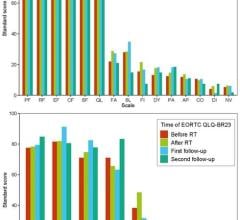
December 10, 2018 — RaySearch has decided to develop a treatment control system, RayCommand, to act as a link between its RayStation treatment planning system (TPS) and RayCare oncology information system (OIS). The first customer will be Advanced Oncotherapy plc (AVO), a U.K.-based developer of next-generation proton therapy technology. AVO will use it for the first LIGHT (Linac Image Guided Hadron Technology) system at the proton therapy facility under construction at Harley Street in central London, U.K.
The RayStation TPS is RaySearch’s main product. It is used to produce a sequence of settings for the treatment machine, designed to produce an optimal distribution of dose in a patient, targeting regions with cancer cells and avoiding surrounding tissues. The planning process involves detailed modeling of patient anatomy and treatment machine components in order to accurately predict and optimize the delivered dose distribution.
By the end of 2017, RaySearch released the first version of its RayCare OIS. An OIS is used to coordinate all the complex procedures that are involved in a comprehensive cancer treatment regime. This includes handling of diagnostic studies and consultation notes, facilitating tumor board meetings, scheduling of resources, data collection, charge capture and follow-up of treatment outcome. RayCare is designed around patient-centric digital workflows that help increase efficiency and quality of care.
Now, RaySearch has decided to develop a treatment control system (TCS), RayCommand. A TCS is the link between the TPS and OIS on one side and the treatment machine on the other. It coordinates and orchestrates the different systems involved, such as the imaging systems, the beam delivery system and the patient support system. This is critical in order to achieve safe and efficient patient treatments. For multi-room proton therapy installation, there is also the extra dimension of coordinating activities between treatment rooms to maximize beam utilization and minimize wait times.
The decision to build a TCS is connected to an order from AVO for its first proton therapy facility. AVO has previously purchased RayStation and RayCare for the facility and has now also ordered RayCommand. This means that this AVO facility will be the first clinic to use an all-RaySearch software suite with both TPS, OIS and TCS. Tight integration between these systems will ensure a safe and efficient treatment process. RayCommand will build on the user friendliness and attention to detail in RayStation and RayCare, according to RaySearch.
Another important aspect of RayCommand will be to enable online adaptive radiation therapy. Support for offline treatment adaptation has been a key feature in RayStation for many years, but clinical implementation together with the other OIS on the market was cumbersome, which RayCare overcomes. But for online treatment adaptations, the TCS must also be involved and many existing TCS are not designed for this.
Nicolas Serandour, CEO of AVO, said, “RayStation was the obvious choice for TPS to complement our advanced particle therapy treatment technology. It is also clear to us that RayCare represents the next generation in the OIS field. Likewise, for TCS, we wished to offer a next-generation system to take full advantage of the LIGHT capabilities. We are pleased that RaySearch decided to move into this field and work together with us to create a fully integrated solution with our technology. The unified TPS-OIS-TCS-LIGHT chain is expected to bring the prospect of truly personalized medicine to our proton therapy installations.”
For more information: www.raysearchlabs.com


 March 28, 2024
March 28, 2024 








